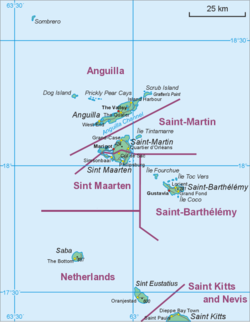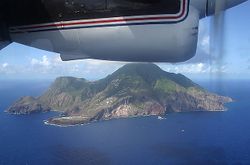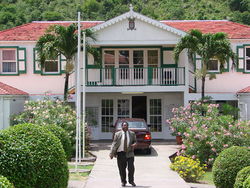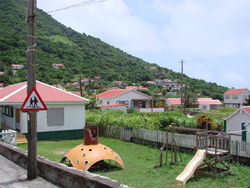Saba
Not to be confused with Sabah, a Malaysian state.
| Island Territory of Saba
Eilandgebied Saba
|
||||
|---|---|---|---|---|
|
||||
| Motto: "Remis Velisque" (Latin) "With oars and sails" (English) |
||||
| Anthem: "Saba you rise from the ocean" |
||||
 |
||||
| Capital (and largest city) |
The Bottom |
|||
| Official language(s) | Dutch, English | |||
| Government | See Politics of the Netherlands Antilles | |||
| - | Lieutenant Governor | Jonathan Johnson[1] | ||
| Constitutional monarchy | part of the Netherlands Antilles | |||
| Area | ||||
| - | Total | 13 km2 5 sq mi |
||
| Population | ||||
| - | 2004 census | 1,424 | ||
| - | Density | 104/km2 285/sq mi |
||
| Currency | Netherlands Antillean guilder (ANG) |
|||
| Time zone | -4 (UTC-4) | |||
| Internet TLD | .an | |||
| Calling code | 599 | |||
Saba (pronounced /ˈseɪbə/) is the smallest island of the Netherlands Antilles, located at . It consists largely of the potentially active volcano Mount Scenery (877 m), the highest point of the Kingdom of the Netherlands.
Saba has a land area of 13 km² (5 sq. miles). At the 2001 Netherlands Antilles census, the population was 1,349 inhabitants, which means a population density of 104 inhabitants per km². In 2004 the population was estimated at 1,424 inhabitants. The official languages are Dutch and English, although there is a local dialect.
Its current major settlements include The Bottom, Windwardside, Hell's Gate and St. Johns. Both Dutch and English are official languages. Despite the island's Dutch affiliation, English is the principal language spoken on the island and has been used in its school system since the 19th century. The Netherlands Antillian Guilder (ANG) is the official currency, but the U.S. dollar is accepted everywhere on the island. Starting January 1, 2011, however, the U.S. dollar will take over as the official currency.[2]
Saba is home to the Saba University School of Medicine, which was established by American expatriates in coordination with the Netherlands government. The school adds over 300 residents when classes are in session, and it is the prime educational attraction. A.M. Edwards Medical Center is the major provider of healthcare for local residents.
Saba is slated to become a special municipality within the country of the Netherlands, and currently the schedule for this transition has been set for October 10, 2010.[3]
The island declared its intention to become independent from the Netherlands Antilles on 1 September 2009 whilst stating that it will adhere to its referendum result of 86% in favour of direct ties with the Netherlands [4]. However, according to Dutch State Secretary Bijleveld for Kingdom Relations, it is at this moment not legally possible for Saba to become independent from the Antilles[5].
Contents |
History
The origin of the name "Saba" is often mistakenly believed to be derived from the Arawak Indian word for "rock", which was "siba". However, the true source of the name Saba \s(a)- ba\ is of Greek and Arabic (colloquial Arabic Saba سابا and classical Arabic سبأ ) origin, and its meaning is from Sheba: "morning". Saba refers to the Biblical queen of Sheba. Christopher Columbus is said to have sighted Saba on November 13, 1493, but he did not land, as the island's perilously rocky shores were a major deterrent to Columbus and his crew. In 1632 a group of shipwrecked Englishmen landed upon Saba; they stated they found the island uninhabited when they were rescued. However, there has been some evidence found indicating that Carib or Arawak Indians may have been on the island.
In 1635 a stray Frenchman claimed Saba for Louis XIII of France and around the year 1640, the Dutch Governor of the neighboring island of St. Eustatius sent people over to colonize the island for the Dutch West India Company. In 1664, these settlers were evicted to St. Maarten by Thomas Morgan, The Netherlands have been in continuous possession of Saba since 1816 after numerous flag changes (British-Dutch-French) during the previous centuries.
In the 17th and 18th centuries its major industries were sugar and rum, and later fishing, particularly lobster fishing. In the 1600s Saba was believed to be a favorable hideout for Jamaican pirates. England also deported its "undesirable" people to live in the Caribbean colonies. They too became pirates, taking haven on Saba. The most notable native Saban pirate was Hiram Beakes, who famously quipped "Dead Men Tell No Tales." Legitimate sailing and trade later became important and many of the island's men took to the seas, during which time Saba lace became an important product made by the island's women.
The remains of the 1640 settlements can be found on the west side at Tent Bay. They were destroyed by a landslide already in the 17th century.
Geography and ecology
The environment of Saba is mainly composed of woodland forest with ferns and damp soil, and many mango trees. There used to be forests of Mountain Mahogany trees until a hurricane in the 1960s destroyed many of the trees. These are Freziera undulata [Theaceae], and unrelated to other Mahogany species, one of which is, however, planted at lower levels on the island small-leaved mahogany, Swietenia mahagoni [Meliaceae]. The Mahogany trees are considered at risk of going extinct on the island. Visitors refer to Saba's forests as "the Elfin Forest" because of its high altitude mist and mossy appearance. Since then there has been a woodland reserve created and aptly named "Elfin Forest Reserve". Saba's lush plant and animal wildlife are diverse and are looked after by the Saba Conservation Foundation.
4.3 km southwest of Saba is the Saba Bank, a large submerged atoll of rich biodiversity, and a prime fishing ground, particularly for lobster.
People and culture

The population of Saba (the Sabans) consists of only 1,424 people who come from all over the world. The island's small size has led to a fairly small number of island families, who can trace their last names back to around a half-dozen families. This means that many last names are shared around the island, the most numerous being Hassell and Johnson. Most families are a rich intermixing of Dutch, Scottish, and African heritage. The population is also descended from the Irish who were exiled from that country after the ascension of King Charles I of England in 1625; Charles exiled these Irish to the Caribbean in an effort to quell rebellion after he had forcibly procured their lands for his Scottish noble supporters.
Historically, the island was traded among the many European nations that fought for power in the region. Slaves were also imported to work on Saba. Both English and Dutch are used on the island and taught in schools, though Dutch is the island's official language. In more recent years Saba has become home to a large group of expatriates, and around 250 immigrants who are either students or teachers at the Saba University School of Medicine. Sabans are mostly Roman Catholic by faith; however, there is also a Wesleyan Church Holiness community on the island. Other religions practiced on the island include Anglican, Seventh-day Adventist, Muslim, and Jewish faiths.
Due to the very small size of the island, as well as the difficulty with which the steep slopes made farming, many Sabans took to the sea, making their living as legitimate sailors. Their seafaring traditions made it not uncommon for many men to seek better employment in the United States Navy; forging their birth certificates to enter the U.S. Navy without obstruction was also not uncommon. Although the details of his early personal biography are virtually unknown, one of these Saban sailors was possibly Chief Boatswain Edwin J. Hill, who received the United States' highest military honor, the Navy version of the Medal of Honor posthumously, for heroism during the Japanese attack on Pearl Harbor in 1941 in which he died (due to the commonplace practice of one's forging his birth certificate to enter the U.S. Navy, Hill's Saban birth cannot be absolutely proven; however, it is known that his immediate and extended family were Saban).
Transport

There is one road, aptly called "The Road". Its construction was masterminded by Josephus Lambert Hassell who, despite the common opinion of Dutch and Swiss engineers, believed that a road could be built.[6] He took a correspondence course in civil engineering, and started building the road with a crew of locals in 1938.[7] After five years of work, the first section of the road, from Fort Bay to The Bottom, was completed. It was not until 1947, however, that the first motor vehicle arrived. In 1951, the road to Windwardside and St. Johns was opened, and in 1958 the road was completed. Driving "The Road" is considered to be a daunting task, and the curves in Windwardside are extremely difficult to negotiate. Driving is on the right hand side.
In 1963 the island built a 400 metre landing strip for easier trips to the island using aircraft: Juancho E. Yrausquin Airport. This landing strip is reputed to be the shortest commercial runway in the world, and as such, only three models of airplane are able to land there regularly. Consistent air service from Sint Maarten and Sint Eustatius is available through Windward Island Airways (Winair). In 1972 a pier was completed in Fort Bay to access the island and this has made it easier for visitors to come there. Travel is also provided by ferry services to and from Sint Maarten with the Dawn II and The Edge.
Of note in The Bottom area, are 800 steps carved from stone, that go from Ladder Bay to The Bottom. Everything was carried to the island by hand until the late 20th century.
Economy



Saba lace (also known as "Spanish work") was a major export of Saba. In the 1870s, as a young lady, Mary Gertrude Hassell Johnson, was sent to a Caracas convent in Venezuela for study – where she learned the difficult craft. The lacework spread through the island. The women of Saba began a mail-order business, and would copy addresses of businesses off of shipping containers from the United States, and write to the employees. Often they would get orders for the lacework, and it started a considerable cottage industry. By 1928, the women were exporting around $15,000 (USD) worth of lace products each year.
Tourism
The island of Saba is known today for tourism, especially its ecotourism. Because the island is relatively new to the tourism industry, it only sees about 25,000 visitors each year. Saba is increasing in its popularity as a vacation destination because of its excellent scuba diving, climbing and hiking. The scuba diving in particular is deep and somewhat challenging; even though Saba is a small island it actually supports not one, but two hyperbaric chambers in case of diving emergencies.
There are few anchorages, and a small airport with service from St. Maarten and Sint Eustatius. There is also a ferry service from St. Maarten. The ferries Dawn II and The Edge both travel to Saba three times a week. Saba's brilliantly colorful and pristine coral life make it one of the most sublime places to scuba dive in the world, and is often listed as one of the Top 10 diving destinations. Many attribute the underwater life's purity to the island's remoteness and the caring of the people. The waters around the island were designated as the Saba National Marine Park in 1987, subject to government regulation to preserve its coral reefs and other marine life. Thus, Saba is known as "The Unspoiled Queen" of the Caribbean.[8] Saba has inns, hotels, rental cottages and restaurants.[9]
Notable Sabans
- Hiram Beakes – 18th Century pirate who originated the phrase, "Dead men tell no tales."
- Edwin J. Hill – Recipient (posthumously) of the United States Navy Medal of Honor for heroism during the Japanese attack on Pearl Harbor, December 7, 1941. (Believed to be a Saban native who forged a birth certificate in order to enter the U.S. Navy.)
References
- ↑ http://www.sabatourism.com/communitynews501.html
- ↑ [1]
- ↑ [2]
- ↑ http://www.nu.nl/algemeen/2072669/saba-stapt-uit-de-nederlandse-antillen.html
- ↑ http://www.telegraaf.nl/binnenland/4730393/__Bijleveld__helder_signaal_van_Saba__.html
- ↑ "Saba Dutch Caribbean Travel Guide". LukeTravels.com. http://www.luketravels.com/saba/. Retrieved 2007-10-06.
- ↑ Diane Slawych. "Saba’s road less travelled". Canoe.ca Travel. http://travel.canoe.ca/Travel/Caribbean/LesserAntilles/2006/11/15/2365625-sun.html. Retrieved 2007-10-06.
- ↑ Saba Tourist Bureau Official site. Retrieved Aug 2010.
- ↑ Saba Tourist Bureau Official site. Retrieved Aug 2010.
External links
- Saba travel guide from Wikitravel
- Island Government of Saba homepage
- Saba's Tourist Bureau homepage
- Saba Conservation Foundation's homepage
- Saba (N.A.): Bos en nationale parken. 54pp.
|
|||||||
|
|||||||||||||||||||||||||||||||||||||
